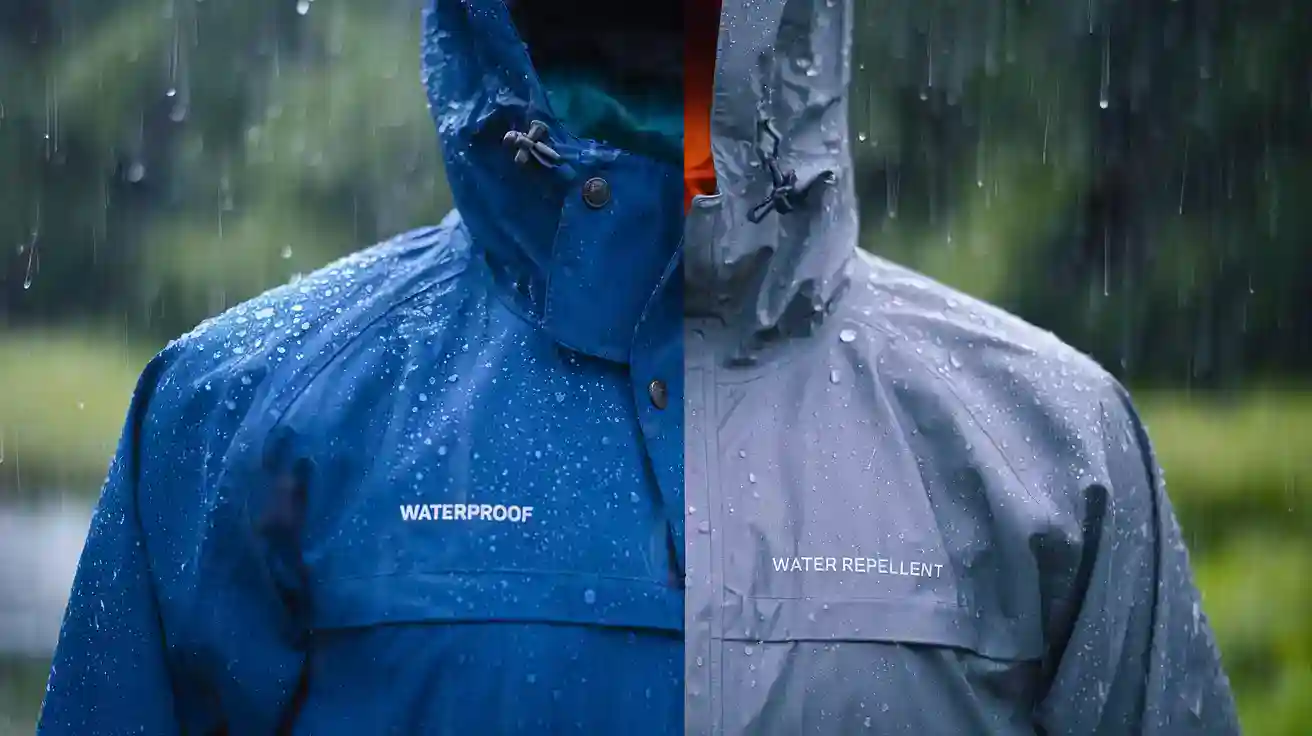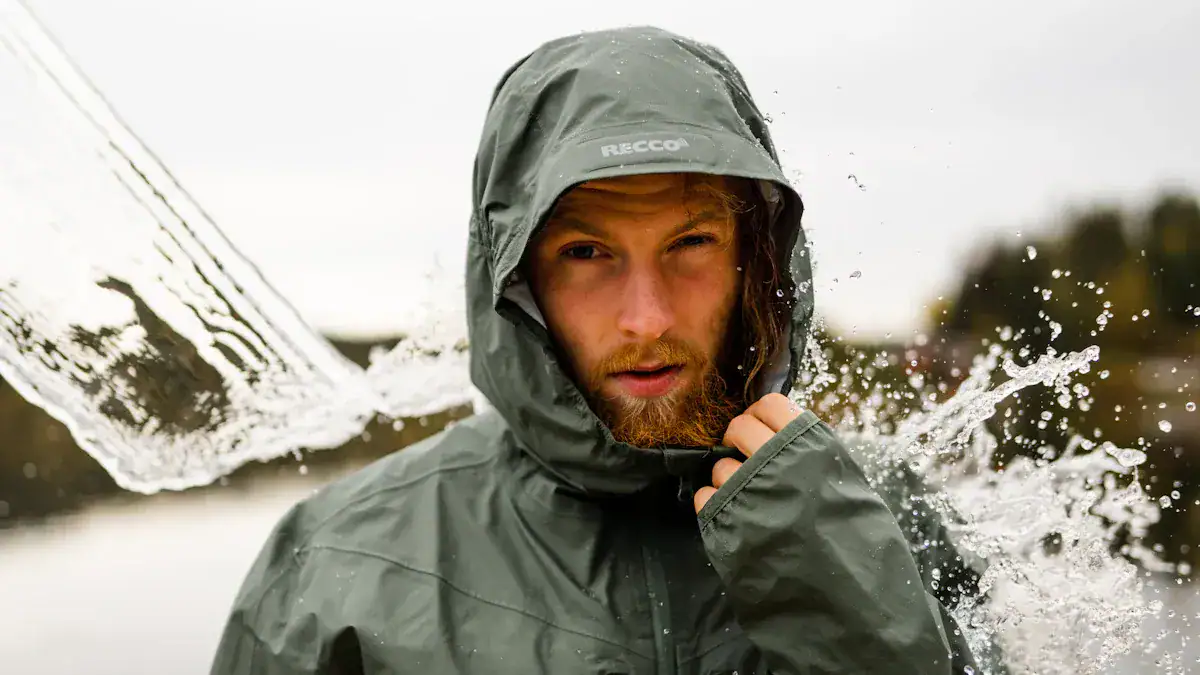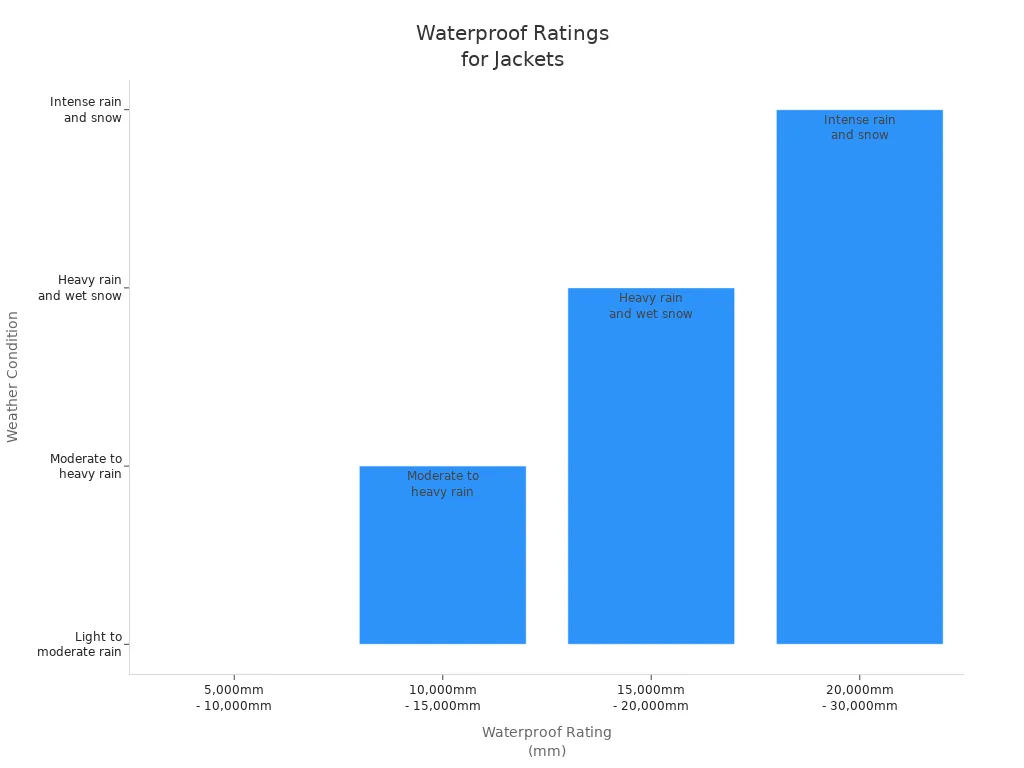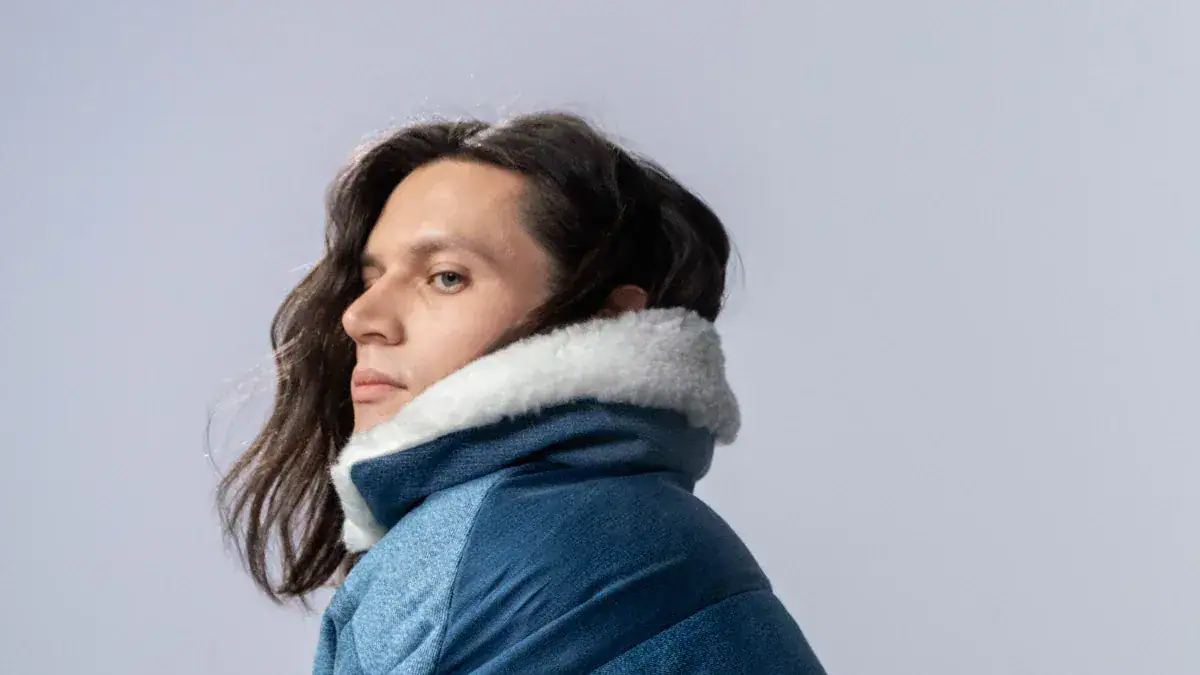The difference between waterproof jackets and water-repellent jackets

The main difference between waterproof jackets and water-repellent jackets lies in how each handles wet conditions. I remember stepping outside during a sudden downpour, hoping my jacket would keep me dry. Selecting the right jacket matters because it determines comfort and protection. Waterproof jackets block rain and moisture completely, while water-repellent jackets only resist light showers. I want to help you understand how each type performs when the weather turns wet, so you can make a smart choice.
Key Takeaways
- Waterproof jackets provide complete protection against rain and moisture, making them ideal for heavy downpours.
- Water-repellent jackets resist light rain but do not block water completely, suitable for short outings in mild weather.
- Look for features like sealed seams and waterproof membranes to identify a true waterproof jacket.
- DWR (Durable Water Repellent) coatings enhance water-repellent jackets, causing water to bead up and roll off.
- Regular maintenance is crucial; waterproof jackets need less frequent care than water-repellent jackets, which require reapplication of DWR treatments.
- Choose a waterproof jacket for activities like hiking or skiing in wet conditions, and a water-repellent jacket for casual wear or light rain.
- Understanding the difference between waterproof and water-repellent jackets helps you make informed choices for outdoor activities.
- Always match your jacket choice to the expected weather conditions for optimal comfort and protection.
Waterproof Jackets

When I look for true protection from rain, I always turn to waterproof jackets. These jackets offer complete defense against water penetration, making them essential for anyone who spends time outdoors in unpredictable weather. The industry classifies a jacket as waterproof based on its ability to block water entirely, even during heavy downpours.
Waterproof Features
Membranes
The core of most waterproof jackets lies in their membranes. I often see materials like Gore-Tex and polyethylene used because they provide a barrier that stops water from passing through. These membranes also allow sweat vapor to escape, which keeps me comfortable during activity. The table below compares common membrane materials:
| Material | Water Resistance Rating | Breathability |
|---|---|---|
| Polyethylene | High | Low |
| Gore-Tex | Very High | High |
| Rubber | High | Low |
| Nylon | Moderate | High |
| Polyester | Moderate | High |
Seams
A jacket’s seams can make or break its waterproof performance. I always check for fully taped or welded seams. Manufacturers heat-glue thin, flexible tape to all seams, which prevents water from leaking through the stitching. Some jackets use seam welding, where fabrics are melted together for a watertight seal. These features ensure the jacket remains waterproof even in the harshest conditions.
- Seam taping: Waterproof tape is heat sealed to the inner lining, visible and replaceable.
- Seam welding: Fabrics are melted together to create watertight seams.
- Fully seam-sealed jackets use tape on all seams for maximum waterproof integrity.
Materials
Fabrics
Waterproof jackets use tightly woven fabrics like nylon or polyester. These fabrics resist water naturally, but the real magic happens when combined with membranes and coatings.
Coatings
Manufacturers often add a polyurethane coating or a Durable Water Repellent (DWR) treatment to the outer layer. DWR creates a hydrophobic surface, causing water to bead up and roll off instead of soaking in. This treatment boosts the jacket’s waterproof performance and keeps me dry longer.
Performance
Waterproof jackets excel in heavy rain and prolonged exposure. I have worn them during intense storms and stayed dry, even when others in water-repellent jackets got soaked. The hydrostatic head rating measures how waterproof a fabric is, with higher numbers indicating better protection. Many waterproof products exceed 10,000mm, making them suitable for extreme conditions.
| Waterproof Rating | Conditions | Description |
|---|---|---|
| 5,000mm – 10,000mm | Light to moderate rain | Entry-level waterproof rating suitable for daily wear and light outdoor activities. |
| 10,000mm – 15,000mm | Moderate to heavy rain | Mid-level waterproof rating for hiking and cycling. |
| 15,000mm – 20,000mm | Heavy rain and wet snow | High-level waterproof rating ideal for prolonged outdoor activities. |
| 20,000mm – 30,000mm | Intense rain and snow | Professional-grade waterproof rating for extreme conditions. |

I rely on waterproof jackets for hiking, skiing, and even theme park visits. These jackets outperform water-repellent options in simulated heavy rain, keeping me dry while allowing sweat to escape. For anyone who needs reliable protection, waterproof products remain the top choice.
Water-Repellent Jackets

When I need a lightweight layer for unpredictable weather, I reach for a water-repellent jacket. The textile industry defines a water-repellent jacket as a garment treated with a finishing process that creates breathable materials resistant to water. These jackets rely on hydrophobic properties and a Durable Water Repellent (DWR) finish to shed moisture. I find that water-repellent jackets offer surface-level protection, making them ideal for light rain and damp conditions.
Water-Repellent Features
DWR Coating
The DWR coating stands out as the main feature of any water-repellent jacket. Manufacturers apply this ultra-thin layer to the fabric surface, forming a protective barrier. I notice that water droplets bead up and roll off instead of soaking in. The DWR coating works by creating tiny, rigid microscopic bristles that prevent water from grabbing onto the fabric.
The DWR coating is applied in an ultra-thin layer to the surface of the fabric. The goal of DWR is to shed moisture and it achieves this by forming a protective layer of tiny, rigid microscopic bristles that don’t allow water droplets to grab onto the surface of the fabric.
I often see DWR applied during manufacturing, but I can also refresh it with spray-on treatments. The effectiveness of DWR usually lasts for about 20 washes, so I make sure to reapply it when I notice water no longer beads up.
| Mechanism | Description |
|---|---|
| Water Beading | DWR creates a barrier that causes water to bead up and roll off the fabric. |
| Application | DWR can be applied during manufacturing or as a spray-on treatment. |
| Durability | Typically lasts for about 20 washes in outdoor apparel. |
Fabric Treatment
Water-repellent jackets use several fabric treatments to enhance their performance. I rely on sprays, wash-in solutions, and waxes to maintain water-repellent qualities. Here are some common treatments I have used:
| Treatment Type | Description |
|---|---|
| Sprays | Easy to apply, available in aerosol or pump forms, requires periodic reapplication. |
| Scotchgard Fabric | An aerosol spray that beads water but may not be fully waterproof; requires reapplication after use. |
| Nikwax Cotton Proof | Wash-in treatment for cotton that maintains breathability; water-based and nearly odorless. |
| Otter Wax | A natural wax applied to fabrics, labor-intensive, may alter fabric appearance and texture. |
Materials
Treated Fabrics
Most water-repellent jackets use synthetic fabrics like nylon or polyester. These materials receive special treatments to boost their water repellent properties. I prefer jackets with treated fabrics because they remain lightweight and breathable. The hydrophobic nature of these materials helps keep me dry during short showers.
Waxed Cotton
Waxed cotton offers a classic alternative for water-repellent jackets. I appreciate its good water resistance and ability to manage heat and moisture. Waxed cotton allows some airflow, which helps regulate temperature. However, it does not provide full waterproof protection. I choose waxed cotton jackets for casual outings and mild weather.
| Fabric Type | Water Resistance | Breathability |
|---|---|---|
| Waxed Cotton | Good water resistance, not fully waterproof | Allows some airflow, manages heat and moisture |
| Synthetic Treated | Often fully waterproof, limits breathability | May not allow moisture to escape, leading to discomfort |
Performance
Water-repellent jackets excel in light rain and drier conditions. I wear them for hiking, running, and travel when I need a packable layer. The water-repellent finish causes droplets to bead and roll off, keeping me dry during brief showers. I notice that these jackets do not perform as well in heavy rain or prolonged exposure. The water repellent treatment eventually wears off, so I reapply it to maintain protection.
Water-repellent jackets suit outdoor activities where breathability and weight matter. I use them for backcountry trips and performance-oriented missions. These jackets combine tough fabrics with water-repellent qualities, making them versatile for everyday wear.
- Lightweight and easy to pack
- Ideal for hiking, running, and travel
- Best for light rain and damp conditions
- Require periodic maintenance to restore water-repellent finish
I always consider the weather and my planned activity before choosing a water-repellent jacket. For short outings and mild climates, these jackets provide the right balance of comfort and protection.
Key Differences
Protection Level
When I compare protection levels, I notice a clear distinction between waterproof and water-repellent jackets. Waterproof jackets provide complete defense against moisture. I rely on them during heavy rain or snow because they block water from penetrating the fabric. Manufacturers design these jackets with advanced membranes and sealed seams, which create a barrier that keeps me dry even in extreme conditions.
Water-repellent jackets, on the other hand, offer surface-level protection. I use them for light drizzle or damp weather. The fabric treatment causes water to bead up and roll off, but it does not prevent water from soaking through during prolonged exposure. Water resistant jackets, such as soft shells and windbreakers made of lightweight nylon, give me basic protection for short outings.
Outdoor safety guidelines recommend waterproof jackets, like PVC rainwear, for heavy rain. For light drizzle, water resistant jackets work well. When I need optimal waterproofing and breathability, I choose jackets made from GORETEX.
| Jacket Type | Protection Level | Best For |
|---|---|---|
| Waterproof | Complete | Heavy rain, snow, all-weather use |
| Water-repellent | Surface-level | Light drizzle, damp conditions |
| Water resistant | Basic | Short outings, mild weather |
Breathability
Breathability plays a major role in my comfort during outdoor activities. Waterproof jackets often use advanced membranes, such as GORETEX, which allow sweat vapor to escape while blocking water. I find these jackets suitable for hiking and skiing because they balance waterproof protection with breathability.
Water-repellent jackets usually feature lightweight fabrics and minimal coatings. These jackets feel more breathable than fully waterproof options. I wear them when I need ventilation and freedom of movement. Water resistant jackets also provide good airflow, making them ideal for running or cycling in mild weather.
- Waterproof jackets: Advanced membranes offer breathability, but some models may feel less ventilated.
- Water-repellent jackets: Lightweight and breathable, best for active use in light rain.
- Water resistant jackets: Excellent airflow, suitable for high-intensity activities.
Durability
Durability determines how long my jacket will last and how well it maintains its water resistance. High-quality waterproof jackets typically last between 3 to 5 years. Material quality, frequency of use, and maintenance practices influence their lifespan. I notice that regular cleaning and proper storage help extend the life of my waterproof gear.
Water-repellent jackets tend to have a shorter lifespan. The water resistance treatment wears off after repeated washing or exposure to harsh conditions. I often need to reapply DWR coatings to restore their effectiveness. Water resistant jackets made from sturdy nylon or polyester can last for several seasons, but they require periodic maintenance to keep their protective qualities.
- Waterproof jackets: 3–5 years average lifespan with proper care.
- Water-repellent jackets: Shorter lifespan; require frequent reapplication of water resistance treatments.
- Water resistant jackets: Durable for everyday use; maintenance needed to preserve water resistance.
Maintenance
I always pay close attention to how much effort goes into maintaining my outerwear. The maintenance requirements for waterproof and water-repellent jackets differ significantly. I find that proper care extends the life and performance of each type.
For waterproof jackets, I follow a strict cleaning routine. I use mild detergents and avoid fabric softeners because harsh chemicals can damage the waterproof membrane. I wash my jacket only when necessary, usually after heavy use or exposure to mud. I hang it to dry in a well-ventilated area. I check the seams and membrane regularly for signs of wear. If I notice water soaking through, I reapply a Durable Water Repellent (DWR) spray to the outer layer. I never iron or dry-clean my waterproof jacket since high heat can ruin the protective features.
Water-repellent jackets require more frequent maintenance. The DWR coating wears off after several washes or exposure to dirt and oils. I refresh the water-repellent finish with spray-on or wash-in treatments. I clean my jacket with gentle soap and rinse thoroughly. I avoid using bleach or strong detergents. I inspect the fabric for fading or loss of water beading. When the jacket stops repelling water, I know it is time to reapply the treatment.
Here is a quick comparison of maintenance steps for each type:
| Maintenance Task | Waterproof Jacket | Water-Repellent Jacket |
|---|---|---|
| Washing | Mild detergent, infrequent | Gentle soap, more frequent |
| Drying | Air dry, avoid heat | Air dry, avoid heat |
| DWR Reapplication | As needed, after heavy use | Regularly, after several washes |
| Inspection | Check seams and membrane | Check fabric and water beading |
| Ironing/Dry Cleaning | Never | Never |
Tip: I always read the care label before cleaning any jacket. Following manufacturer instructions helps preserve water resistance and extend the lifespan.
Regular maintenance keeps my jacket performing at its best. I invest a little time in care, and I get reliable protection every time I step outside.
Choosing the Right Jacket
Weather Conditions
When I choose between a waterproof jacket and a water-resistant jacket, I always start by thinking about the weather I expect to face. If I know I will spend time in heavy rain or wet snow, I reach for a waterproof jacket. These jackets keep me dry during long hikes, mountain trips, or when I expect unpredictable storms. I have learned that waterproof jackets use advanced fabrics and sealed seams to block out water completely.
For light rain or quick errands, I prefer a water-resistant jacket. These jackets handle drizzle and short showers well. I often wear a water-resistant rain jacket when I walk around the city or go for a jog in mild weather. I have noticed that many people confuse water-resistant jackets with waterproof ones. This mistake can leave them soaked if the rain gets heavier than expected.
Tip: Always match your jacket to the worst weather you might face, not just the forecast.
Activities
My activity plans play a big role in my jacket choice. When I go hiking in the mountains or plan a multi-day camping trip, I never risk it—I pack a waterproof rain jacket. These jackets protect me from sudden downpours and keep me comfortable during long outdoor adventures.
For casual outings, travel, or running errands, I rely on a water-resistant jacket. These jackets feel lighter and more breathable, which makes them perfect for active days when I want to move freely. I also use a water-resistant rain jacket for cycling or running, especially when I expect only light rain.
Here are some common mistakes I see people make when picking a jacket:
- Many confuse water-resistant jackets with waterproof ones, thinking both offer the same level of protection.
- Some forget to consider the actual weather and activity, which leads to poor choices and discomfort.
Comparison Table
To help you decide, I created a quick comparison table that highlights the main differences between waterproof and water-resistant jackets:
| Feature | Waterproof Jackets | Water-Resistant Jackets |
|---|---|---|
| Material | High-tech waterproofing fabrics (e.g., Gore-Tex) | DWR coated fabrics |
| Protection Level | Full protection in heavy rain or snow | Good for light to moderate rain |
| Use Cases | Hiking in mountains, camping in wet areas | Urban wear, casual outdoor use |
| Breathability | Allows sweat escape while blocking water | Strikes a balance between protection and breathability |
| Cost | Generally more expensive | More affordable than waterproof options |
| Scenario | Recommended Jacket Type |
|---|---|
| Frequent heavy rain | Waterproof jacket with sealed seams |
| Mountain expeditions or multi-day hikes | Premium waterproof outerwear |
| Light rain and casual use | Water-resistant jacket |
Note: Experts agree that the most important factor is the level of water protection you need. Waterproof jackets work best for heavy rain and long exposure, while water-resistant jackets suit light moisture and short trips.
I always weigh my climate, activity, and budget before making a choice. A waterproof rain jacket costs more but offers peace of mind in harsh weather. A water-resistant jacket saves money and feels lighter for everyday use. By matching my jacket to my needs, I stay comfortable and dry no matter what the day brings.
The main difference comes down to protection: waterproof jackets block water completely, while water-repellent jackets only resist moisture for a short time. I rely on waterproof jackets for heavy rain or harsh weather. I choose water-repellent jackets for light showers or dry conditions. Here is a quick comparison:
| Feature | Waterproof Jackets | Water-Resistant Jackets |
|---|---|---|
| Protection Level | Highest | Lower |
| Ideal Conditions | Heavy rain, snow | Drier, light rain |
I always match my jacket to my needs and local climate for the best comfort and protection.
FAQ
What is the difference between waterproof and water-repellent jackets?
I notice waterproof jackets block water completely, even in heavy rain. Water-repellent jackets resist moisture for a short time. I choose waterproof for full protection and water-repellent for light showers.
How do I know if my jacket is waterproof?
I check for features like sealed seams, waterproof membranes, and a high hydrostatic head rating. Manufacturers often label jackets as waterproof. I always read the product description before buying.
Can I make my water-repellent jacket waterproof?
I cannot turn a water-repellent jacket into a truly waterproof one. I can reapply DWR treatments to improve water resistance, but the fabric and seams will not block heavy rain.
How often should I reapply DWR to my jacket?
I reapply DWR every 20 washes or when water stops beading on the surface. I use spray-on or wash-in treatments. Regular maintenance keeps my jacket performing well.
Are waterproof jackets less breathable than water-repellent jackets?
I find waterproof jackets with advanced membranes offer good breathability. Water-repellent jackets usually feel lighter and more ventilated. I choose based on my activity and comfort needs.
What activities suit water-repellent jackets best?
I wear water-repellent jackets for hiking, running, and travel in light rain. These jackets work well for short outings and mild weather. I avoid them during heavy storms.
Do waterproof jackets require special care?
I wash my waterproof jacket with mild detergent and air dry it. I avoid fabric softeners and high heat. I inspect seams and membranes regularly to maintain performance.
Can I use a waterproof jacket in snow?
I use waterproof jackets in snow because they block moisture and keep me dry. I look for jackets with insulation for extra warmth during winter activities.

